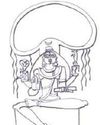
The question was - what do we mean when we say that the end goal of yoga is self-realization / liberation / / Moksha Kaivalya? It was extremely difficult to comprehend the exact meaning of liberation and its practical implication in real life. How would our life look like if we happened to liberate ourselves?
We spoke to innumerable learned people in the field of yoga to understand the various definitions of liberation and we found that liberation meant:
1. Stopping mind modifications.
2. Coming out of the birth-death cycle.
3. Realizing that you are not your body, mind and senses.
4. You have burnt all your Karmas
5. You are an ardent devotee.
6. You are individual consciousness in union with higher consciousness.
7. Aham Bramhasmi (you are Brahman).
8. You realise the truth of . Advaita
9. Vairagya.
10. Attaining and so Dharma Megha Samadhi on.... With all these definitions and tons of apprehensions in our mind, we decided to follow the path integrating three things Yogic and calling it a PID model –
1) Patanjali (PYS).Yoga Sutras
2) Infusion along with Ahar-Vihar-Achar Vichar (AVAV).
3) Discourses by Hansaji.
I. Patanjali Yoga Sutras (PYS)
A must-read text for every yoga enthusiast and practitioner, PYS authoritatively claims that the one who follows the eight limbs of yoga ( ) would walk on the path of Ashtanga liberation. The entire methodology of Ashtanga Yoga has a potential to transform the practitioner holistically and comprehensively. The only requirement is consistent practice and faith. These limbs are:
This story is from the {{IssueName}} edition of {{MagazineName}}.
Start your 7-day Magzter GOLD free trial to access thousands of curated premium stories, and 9,000+ magazines and newspapers.
Already a subscriber ? Sign In
This story is from the {{IssueName}} edition of {{MagazineName}}.
Start your 7-day Magzter GOLD free trial to access thousands of curated premium stories, and 9,000+ magazines and newspapers.
Already a subscriber? Sign In

Moringa Flowers
Edible flowers? Yes! Ayurveda mentions many edible flowers. One of them is the Moringa flower.

You Gain Some, You Lose Some
Recently, we the Chennaites, got the opportunity to get blessings from His Sharada Peetam.

A Healthy Body
An incident from Swami Vivekananda's Life

A Man Himself is Responsible for His Deeds
Renouncing doer-ship

The Unstructured Drama of Life
Go for the silent roles

Positive Thinking and Meditation
A life-raft for seniors

Soul Connects
The Yoga Institute’s Reach Out Camp

The Wood Wide Web
As a kid, Suzanne Simard grew up in the rainforests of British Columbia and she normally spent her summers visiting forests around and exploring them along with her family, which included a curious dog named Jiggs.

More About Dharma and Duty
Considering One's Own Background (Part 2)

Devaluing Your Value
The lure of more